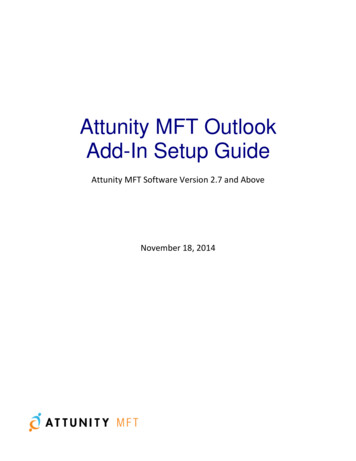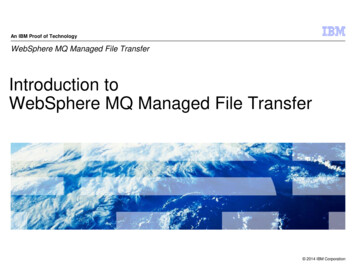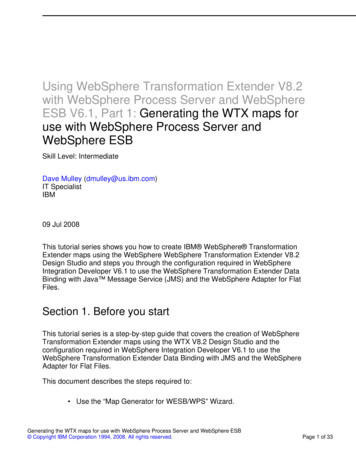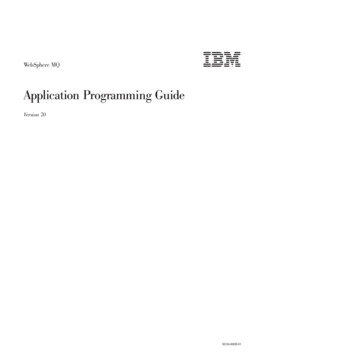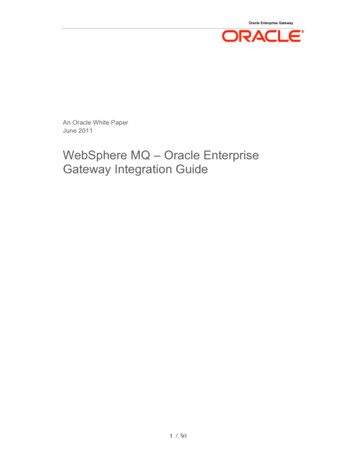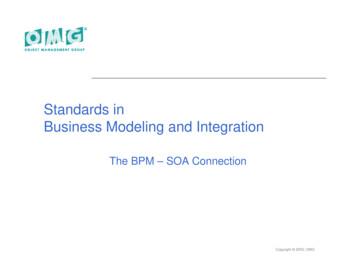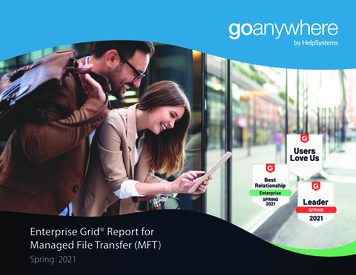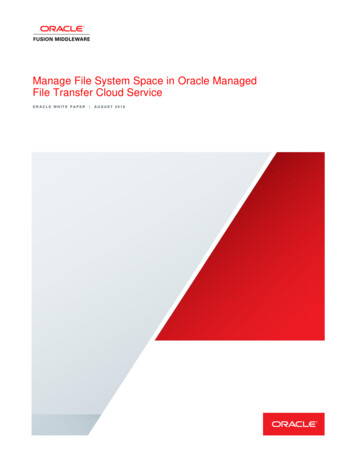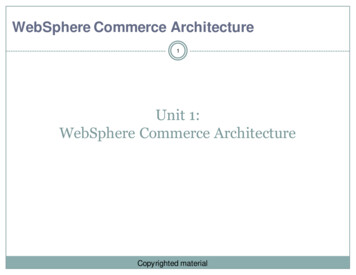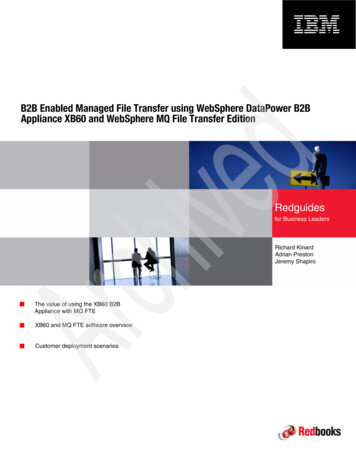
Transcription
Front coverB2B Enabled Managed File Transfer using WebSphere DataPower B2BAppliance XB60 and WebSphere MQ File Transfer EditionRedguidesfor Business LeadersRichard KinardAdrian PrestonJeremy ShapiroThe value of using the XB60 B2BAppliance with MQ FTEXB60 and MQ FTE software overviewCustomer deployment scenarios
Executive summaryMany organizations devote valuable IT resources to building and maintaining systemsin-house for moving files between applications. Most of these solutions are based on FTPbecause of its simplicity and free availability. While FTP offers a basic mechanism for filesharing, where several applications access an occasionally updated, centrally managedsource file, some enterprises are seeking alternatives for files that are moved betweenapplications as part of business transactions. As volumes of transfers rapidly grow, and withincreased consequences for errors in business data when it is incorrectly transferred, havinga reliable, flexible, cost-effective solution for managed file transfer is increasingly critical fororganizations of all sizes. Additionally, these organizations need to enable transfers acrossboundaries with their trading partners and need to support a wide range of B2B and non-B2Bprotocols with the ability to ensure data security and partner identity while the files traversethe Internet.Business processes extend across the supply chain and value chains on a global basis andcompanies depend upon trading partners to run their businesses smoothly. Processes andrules change constantly and you must quickly disseminate these changes to your tradingpartners. To keep pace, it is crucial that you strengthen your trading partner relationshipsthrough tighter automated integration, so that you can make your trading partners anextension of your enterprise.The appliance model coupled with IBM WebSphere MQ File Transfer Edition (FTE)provides strong business value by accelerating the pace of innovative value-creating processand strategic initiatives allowing customers to utilize B2B services to quickly and securelyconnect to their external partners and integrating the partner connections to your internalMFT solution.To take advantage of the improved file transfer processes, flexibility, and IT efficiency thatcome with moving to a B2B for MFT solution, organizations require pervasive, scalableservices and controls, robust security, and transaction auditability in their infrastructures.Today, enterprises often find themselves struggling to deliver these critical requirementswithout having to handle prohibitive cost, complexity, and hard-to-manage infrastructures.Addressing these challenges requires a pragmatic approach, one that simultaneouslyrecognizes the evolution of standards, the value of existing infrastructure investments, yourorganizational challenges, and how performance can be affected across applications.In this IBM Redguide publication we discuss how the IBM WebSphere DataPower B2BAppliance redefines the boundaries of managed file transfer by extending WebSphere MQ Copyright IBM Corp. 2009. All rights reserved.1
File Transfer Edition with a consumable, dedicated SOA appliance that combines B2Bstandards, simplified integration, exceptional performance, and hardened security for SOAimplementations. Meticulously designed to augment all phases of the SOA life cycle andimplementation, these devices combine a host of essential SOA functions in a specializedappliance that provides easy consumption, deployment, and service delivery.About DataPower B2B Appliance XB60OverviewThe IBM WebSphere DataPower B2B Appliance XB60 is a unique B2B appliance thatdelivers secure trading partner data integration tracking, routing, and security functions in anetwork device, while reducing operational costs and improving performance. The XB60 is anondisruptive technology that allows organizations to extend their existing B2Bimplementations and internal integration infrastructure, thus delivering rapid return oninvestment and reduced total cost of ownership. Key features of the XB60 are as follows: Trading partner management for B2B governance; B2B protocol policy enforcement,access control, message filtering, and data security Application integration with standalone B2B gateway capabilities supporting B2B patternsusing a variety of B2B messaging protocols and file transfer protocols Full featured user interface for B2B configuration and transaction viewing, and to correlatedocuments and acknowledgments displaying all associated events Simplified deployment, configuration, and management, thus providing a quicker time tovalue by establishing rapid connectivity to trading partners Full hardware ESB capability, including:– Acceleration of existing integration hubs– Mainframe modernization and Web services– Any-to-any transformation– Integrated message level security– Sophisticated multi-step message routing, filtering, and processing– Multiple synchronous and asynchronous transport protocols– Configurable quality of service– Detailed logging and audit trail– Standards-based interfaces– Agile, highly flexible underlying scripting and configuration support– XML enablement and wirespeed application integration– Metadata-based integrationWebSphere DataPower B2B Appliance XB60 benefitsThis section describes the benefits provided by the XB60. Simplified deployment and ongoing managementReduces need for in-house skills that are typically needed to deploy and manage a B2Bsolution. The XB60 is a hardened drop-in B2B appliance that is suitable for DMZdeployments. The XB60 uses dedicated, tightly optimized hardware and firmware, andhas no software to install.B2B Enabled MFT using WebSphere DataPower B2B Appliance XB60 and WebSphere MQ FTE2
High security assuranceHigher levels of security assurance certification available only with hardware, includingCommon Criteria Evaluation Assurance Level 4 certification. Exceptional data securityand certificate management built into the appliance. Robust Authentication, Authorization,and Auditing (AAA) capabilities with built-in integration to external repositories. High reliability and assured deliverySwappable redundant components, whole-box VRRP-style failover, RAID 1 for HDDoptions, automated B2B data resends when using industry standard EDIINT protocols.Manual B2B resends that can be initiated by your trading partners. Auditability/monitoringRobust logging and support for saving logs to a large variety of log targets utilizing a broadrange of log formats. Real-time transaction monitoring of B2B transactions utilizing asimple to use B2B Transaction Viewer, which can be configured to allow trading partnersto view their own transactions. FlexibilitySupport for a wide range of protocols to allow flexibility to connect to as many tradingpartners as possible. Many back-side protocols are supported to provide more options forintegrating to back-end applications. Supported connection protocols include http(s),ftp(s), sftp, POP3, SMTP, MQ, JMS, AS1, AS2, AS3, NFS, IMS Connect, TIBCO EMS,and ODBC (DB2 , Oracle, MS SQL). Low total cost of ownershipDedicated B2B appliances have been shown to reduce deployment and operational costsby as much as 50%. Dramatically decreases the testing time and amount of developmentrequired to upgrade your environment; most policies are configuration-driven as opposedto development-driven.Architecture of the WebSphere DataPower B2B ApplianceThe XB60 builds on top of the DataPower Application Integration appliance by adding tradingpartner profile management, B2B transaction viewing capabilities, and industrystandards-based B2B messaging protocols to the already robust integration capabilities ofthe core appliance. These three key capabilities are at the heart of the B2B Appliance. Theyare designed in such a way that the B2B Appliance is positioned extremely well to handlesimple partner connections with data passing through directly to end applications for furtherprocessing. If more complex data flows are required, the application integration capabilities ofthe XB60 can be used to perform data validation, transformation, rules-based enforcement,and content-based routing. B2B Gateway ServiceThe B2B Gateway Service is a configuration object that is responsible for processing androuting B2B data. Partner profilesPartner profiles are configuration objects that are capable of supporting multipledestinations; the profiles are associated with any number of B2B Gateway Services. B2B Transaction ViewerThe B2B Transaction Viewer is used to view all transactions that pass through a B2BGateway Service.The components that make up the B2B functionality in the XB60 are depicted in Figure 1 onpage 4.B2B Enabled MFT using WebSphere DataPower B2B Appliance XB60 and WebSphere MQ FTE3
Figure 1 WebSphere DataPower B2B Appliance architectureAbout MQ File Transfer EditionOverviewIBM WebSphere MQ File Transfer Edition provides a reliable, managed file transfer solutionfor moving files—regardless of size—between IT systems. It enables files and documents tobe transferred across a dual-purpose backbone that also handles messages. Key features ofWebSphere MQ File Transfer Edition are as follows: Provides reliable managed file transfer (MFT) using WebSphere MQ Enables consolidation of messaging and file transfers into single backbone Provides bulk transfer of files, regardless of size Records log of transfer activity for audit purposes to queues and external databases Automates and controls file movement between IT systems with scheduling, triggering,and directory monitoring Extends MQ Explorer graphical interface for remotely configuring transfers and monitoringprogressB2B Enabled MFT using WebSphere DataPower B2B Appliance XB60 and WebSphere MQ FTE4
Provides command line interface for programmatic control of transfers Provides scripting interface for XML definition of transfers using Apache AntWebSphere MQ File Transfer Edition provides an enterprise-ready managed file transfercapability that is both robust and easy to use. WebSphere MQ File Transfer Edition exploitsthe proven reliability and connectivity of WebSphere MQ to transfer files across a wide rangeof platforms and networks. In addition to leveraging existing WebSphere MQ networks,WebSphere MQ File Transfer Edition can be easily integrated with existing file transfersystems, as illustrated in Figure 2.Managed FileTransferEnterpriseMessagingJava MessageServiceHTTP andWeb 2.0IBM WebSphere MQPublish andSubscribeSOAP andWeb ServicesLow-LatencyMessagingMobile andTelemetryFigure 2 WebSphere MQ File Transfer Edition and the MQ FamilyWebSphere MQ File Transfer Edition benefitsThe benefits provided by WebSphere MQ File Transfer Edition are described in this section. AuditabilityWebSphere MQ File Transfer Edition provides full logging of transfers at both the sourceand destination systems. File transfer audit logs are stored in WebSphere MQ queues andoptionally in a relational database (SQL). Ease-of-useUsing WebSphere MQ File Transfer Edition, file transfers can be initiated using thegraphical user interface in WebSphere MQ Explorer, via command-line commands, andusing scripts. SimplicityWebSphere MQ File Transfer Edition has a low resource footprint, and apart fromWebSphere MQ, has no other pre-requisite software. SecurityAccess to files is controlled by file system permissions. File transfers can be protectedusing SSL encryption and authentication. AutomationFile transfers can be set up to occur at specified times or dates, or repeated at specifiedintervals. File transfers can also be triggered by a range of system events, such as newfiles or updated files.Architecture of WebSphere MQ File Transfer EditionWebSphere MQ File Transfer Edition comprises four components, all supported by one ormore WebSphere MQ queue managers in the network. These components are: AgentsFTE Agents are programs that perform the fundamental file transfer function; for example,they send and receive files from the local system.B2B Enabled MFT using WebSphere DataPower B2B Appliance XB60 and WebSphere MQ FTE5
Configuration commandsThese are commands that are used to control FTE from a command line. Configurationcommands perform tasks such as creating and deleting agents. Administration commandsAdministration commands perform tasks such as creating new file transfers. Graphical user interfaceThis is a point-and-click interface used to configure and administer FTE.The components of WebSphere MQ File Transfer Edition use WebSphere MQ tocommunicate with each other, and the Agents in particular use WebSphere MQ to transportthe contents of files across the network to other Agents (Figure 3).MQ NetworkQueue ManagerAgentAgentQueue ManagerQueue ManagerMQ ExplorerCommand-lineFigure 3 WebSphere MQ File Transfer Edition ArchitectureSample deployment scenariosIn this section we outline a common business scenario for multi-enterprise file transfers. Thedeployment scenario can support the use of any transport and B2B protocol that theDataPower B2B Appliance XB60 has available; however, for the purpose of the two tradingscenarios demonstrated in this guide (Inbound and Outbound) we are utilizing the mostpredominate B2B Messaging protocol: AS2. This allows us to demonstrate how the XB60 canuse profile management to verify and validate the trading partners, B2B messaging to protectthe payload data that is transferred between you and your partners, and providenon-repudiation of origin and receipt for the public side of the connection (Assured Delivery).It also demonstrates how the XB60 integrates with WebSphere MQ File Transfer Edition tofacilitate an intra-enterprise file transfer to any location inside your enterprise.B2B Enabled MFT using WebSphere DataPower B2B Appliance XB60 and WebSphere MQ FTE6
Scenario #1: File transfer inbound from an AS2 trading partnerIn this scenario, illustrated in Figure 4, the trading partner sends an AS2 message containingthe secured payload to the HubOwner’s B2B Gateway (XB60). The file is then routed to a filesystem shared between the XB60 and AGENT01 and an XML command file is sent from theXB60 to MQ FTE instructing MQ FTE to pick up the file and send it to AGENT02.InboundEnterpriseTrading lGatewayServiceB2BGatewayService43ServerServerWS MQAgent01Agent025bW ANProfileMgmtDataStoreTransactionViewerDataStoreMQ ExplorerFTE ViewerDataStoreXB60MQ ExplorerFTE Viewer6ERP ApplicationBrowser(Partner view)Browser(LOB User)Figure 4 Inbound AS2 message routed to the back-end application using MQ FTE1. The trading partner sends an AS2 document into the B2B Gateway over any supportedprotocol. The B2B Gateway Service will use profile management to verify/validate thepartner. If a supported B2B Messaging protocol (AS1, AS2, AS3) is used, the B2BGateway Service ensures that the message adheres to the B2B standard, that datasecurity is appropriately applied, and then removes the B2B protocol packaging.2. The payload is routed into a Multi-protocol Gateway Service, where we use aMulti-protocol Gateway policy to facilitate integration to WebSphere MQ File TransferEdition.3. The Multi-Protocol Gateway policy sends the payload to an NFS mount point that isshared between the XB60 and MQFTE AGENT01.4. The Multi-protocol Gateway policy sends an MQ FTE Command XML file to the MQ FTECommand Queue; this file triggers the MQFTE transfer and tells AGENT01 where to findthe file on the file system and where to send it to over the MQ Network.5. a: If using a B2B Messaging protocol, once the file has been written to the NFS mountpoint and the XML command file has been delivered to the queue, the B2B GatewayService will generate a Message Disposition Notification (MDN) advising the successfultransfer of the file and send that MDN back to the trading partner.b: AGENT01 will consume the XML command file and route the payload to the receivingagent; AGENT02. AGENT02 will then write the file to the destination directory.6. The back-end application will consume the payload that MQ FTE has transferred.B2B Enabled MFT using WebSphere DataPower B2B Appliance XB60 and WebSphere MQ FTE7
Scenario #2: File transfer outbound to an AS2 trading partnerIn this scenario, shown in Figure 5, the HubOwner is the originator of the file. The back-endapplication places the file on the file system where AGENT02 can pick up the file wheninstructed to do so via the mechanisms available in MQFTE. AGENT02 sends the file over theWAN to AGENT01, which writes the file to a file location shared between AGENT01 and theXB60. The XB60 polls the directory on a scheduled polling cycle and picks up the file forprocessing. It parses the file for sender and receiver information and routes the file securelyto the receiving trading partner based on information in the partner profile.OutboundEnterpriseTrading iceServerServerWS ransactionViewer3Agent01Agent022W ANDataStoreMQ ExplorerFTE ViewerDataStoreXB60MQ ExplorerFTE Viewer1ERP ApplicationBrowser(Partner view)Browser(LOB User)Figure 5 File Transfer Outbound to an AS2 Trading Partner1. The back-end application sends a file to a directory shared by AGENT02 and the file isrouted to AGENT01.2. AGENT02 sends the file across the WAN to AGENT01, which writes the file to an NFSmount point that is shared between the XB60 and MQ FTE.3. The B2B Gateway Service picks up the file from the shared NFS mount point, parses thefile for sender and receiver information, and wraps the payload in an AS2 envelope usingthe attributes set up in the recipient’s Trading Partner Profile.4. The B2B Gateway Service sends the file to the trading partner using the AS2 B2BMessaging Protocol.5. The Trading Partner receives the AS2 message, processes it, and sends back an MDN tothe XB60.Note: If you would like to implement these scenarios please contact your local IBMAccount Representative to arrange a proof of technology demonstration.B2B Enabled MFT using WebSphere DataPower B2B Appliance XB60 and WebSphere MQ FTE8
SummaryAs a core part of the IBM SOA Foundation, the WebSphere DataPower B2B appliance andWebSphere MQ FTE offer easy configuration and operation to help reduce operationalcomplexity and to decrease the time required to connect to your trading partners andintegrate to your internal applications. With the WebSphere DataPower B2B appliance, andWebSphere MQ FTE, IBM can help you simplify, accelerate, and secure your B2B for MFTdeployments to increase your flexibility and extend your file transfer processes beyond theenterprise.The team who wrote this paperRich Kinard is a Product Line Manager for IBM Software Group, Application and IntegrationMiddleware Software and is a B2B Subject Matter Expert.Adrian Preston is a lead MQ FTE Developer for IBM Software Group, Application andIntegration Middleware Software and is a WebSphere MQ File Transfer Technologies SubjectMatter Expert.Jeremy Shapiro is a lead DataPower Developer for IBM Software Group, Application andIntegration Middleware Software and is a DataPower Security Subject Matter Expert.Thanks to the following people for their contributions to this Redguide publication:Andre Manriquez, IBM Software Group, Worldwide Sales, B2B Application IntegrationSpecialistBen Mann, IBM Software Group, Application and Integration Middleware Software ProductLine Manager for WebSphere MQ and MQ File Transfer EditionBen Wen, IBM Software Group, Application and Integration Middleware Software DataPowerSOA Appliance Product ManagementChris Rayns, IBM Sales and Distribution, ITSO Project Leader CICS and SecurityDominic Evans, IBM Software Group, Application and Integration Middleware Software,WebSphere MQ Managed File Transfer - DeveloperHumayun (Honda) Bhyat, IBM Sales and Distribution, Software Sales, WebSphere FileTransfer Edition (FTE), WebSphere MQ (WMQ), WebSphere Message Broker (WMB)Matt McLarty, IBM Sales and Distribution, Software Sales, Worldwide Technical SalesManager - WebSphere Connectivity and DatapowerNeal Alewine, IBM Software Group, Application and Integration Middleware Software STSM,WebSphere DataPower ArchitectNiall Clifford, IBM Software Group, Application and Integration Middleware Software, ProjectManager, WebSphere MQ File Transfer EditionPatrick Verdugo, IBM Sales and Distribution, Software Sales Global WebSphere Tiger Team Competency LeaderRichard Cumbers, IBM Software Group, Application and Integration Middleware Software,WebSphere MQ Managed File Transfer DeveloperB2B Enabled MFT using WebSphere DataPower B2B Appliance XB60 and WebSphere MQ FTE9
B2B Enabled MFT using WebSphere DataPower B2B Appliance XB60 and WebSphere MQ FTE10
NoticesThis information was developed for products and services offered in the U.S.A.IBM may not offer the products, services, or features discussed in this document in other countries. Consultyour local IBM representative for information on the products and services currently available in your area.Any reference to an IBM product, program, or service is not intended to state or imply that only that IBMproduct, program, or service may be used. Any functionally equivalent product, program, or service that doesnot infringe any IBM intellectual property right may be used instead. However, it is the user's responsibility toevaluate and verify the operation of any non-IBM product, program, or service.IBM may have patents or pending patent applications covering subject matter described in this document. Thefurnishing of this document does not give you any license to these patents. You can send license inquiries, inwriting, to:IBM Director of Licensing, IBM Corporation, North Castle Drive, Armonk, NY 10504-1785 U.S.A.The following paragraph does not apply to the United Kingdom or any other country where suchprovisions are inconsistent with local law: INTERNATIONAL BUSINESS MACHINES CORPORATIONPROVIDES THIS PUBLICATION "AS IS" WITHOUT WARRANTY OF ANY KIND, EITHER EXPRESS ORIMPLIED, INCLUDING, BUT NOT LIMITED TO, THE IMPLIED WARRANTIES OF NON-INFRINGEMENT,MERCHANTABILITY OR FITNESS FOR A PARTICULAR PURPOSE. Some states do not allow disclaimer ofexpress or implied warranties in certain transactions, therefore, this statement may not apply to you.This information could include technical inaccuracies or typographical errors. Changes are periodically madeto the information herein; these changes will be incorporated in new editions of the publication. IBM may makeimprovements and/or changes in the product(s) and/or the program(s) described in this publication at any timewithout notice.Any references in this information to non-IBM Web sites are provided for convenience only and do not in anymanner serve as an endorsement of those Web sites. The materials at those Web sites are not part of thematerials for this IBM product and use of those Web sites is at your own risk.IBM may use or distribute any of the information you supply in any way it believes appropriate withoutincurring any obligation to you.Information concerning non-IBM products was obtained from the suppliers of those products, their publishedannouncements or other publicly available sources. IBM has not tested those products and cannot confirm theaccuracy of performance, compatibility or any other claims related to non-IBM products. Questions on thecapabilities of non-IBM products should be addressed to the suppliers of those products.This information contains examples of data and reports used in daily business operations. To illustrate themas completely as possible, the examples include the names of individuals, companies, brands, and products.All of these names are fictitious and any similarity to the names and addresses used by an actual businessenterprise is entirely coincidental.COPYRIGHT LICENSE:This information contains sample application programs in source language, which illustrate programmingtechniques on various operating platforms. You may copy, modify, and distribute these sample programs inany form without payment to IBM, for the purposes of developing, using, marketing or distributing applicationprograms conforming to the application programming interface for the operating platform for which the sampleprograms are written. These examples have not been thoroughly tested under all conditions. IBM, therefore,cannot guarantee or imply reliability, serviceability, or function of these programs. Copyright IBM Corp. 2009. All rights reserved.11
This document, REDP-4603-00, was created or updated on November 10, 2009. TrademarksIBM, the IBM logo, and ibm.com are trademarks or registered trademarks ofInternational Business Machines Corporation in the United States, other countries, orboth. These and other IBM trademarked terms are marked on their first occurrence inthis information with the appropriate symbol ( or ), indicating US registered orcommon law trademarks owned by IBM at the time this information was published. Suchtrademarks may also be registered or common law trademarks in other countries. Acurrent list of IBM trademarks is available on the Web athttp://www.ibm.com/legal/copytrade.shtmlRedbooks The following terms are trademarks of the International Business Machines Corporation in the United States,other countries, or both:CICS DataPower DB2 IBM IMS Redguide Redbooks (logo)WebSphere Oracle, JD Edwards, PeopleSoft, Siebel, and TopLink are registered trademarks of Oracle Corporation and/orits affiliates.Other company, product, or service names may be trademarks or service marks of others.B2B Enabled MFT using WebSphere DataPower B2B Appliance XB60 and WebSphere MQ FTE12
WebSphere MQ File Transfer Edition comprises four components, all supported by one or more WebSphere MQ queue managers in the network. These components are: Agents FTE Agents are programs that perform the fundamental file transfer function; for example, they send and receive files from the local system. Managed File

